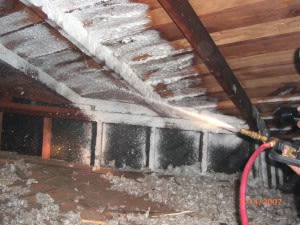Local Treatment vs. Fumigation – Tenting
Often times when people think about termite problems, we automatically jump into the conclusion that fumigation is needed. However, for drywood termite infestations, there are two types of treatment offered to treat drywood termites. So then, what is the difference between local treatment and fumigation? Each treatment options are dependent on the condition and size of the infestation.

Local Treatment – The Non-Moving Alternative
In California, all species of drywood termites infest sound wood areas. For example , structural lumber, decks, lumbers in storage, furniture, and window frames/moldings. These termites are very common in southern California. Luckily, evidences of these termites are easy to find because they leave behind distinctive fecal pellets through surface openings of the infested location. If the termite infestation is manageable and localized, it can be treated with local treatment – also known as spot treatment. Through this method our trained experts can investigate, tackle, and treat the areas of infestation without the hassle/extra expenditure of moving out of your home!

Fumigation – Whole Structure Treatment (House Tenting)
In the case of a large scale termite infestation, termite fumigation is the best way to thoroughly eliminate all drywood termites and other pests. Our termite fumigation specialist uses Vikane gas (DOW), an odorless gas that leaves no residuals on infrastructure/objects. Compared to local treatment, the only shortcoming is that it is a more costly option, and requires residents to vacate the property for 2 nights 3 days during the fumigation. Not only that, but it requires following a few procedures. However, we our clients thoroughly informed and make it our priority to make the tenting process as seamless as possible. It can seem intimidating, but the rewards are well worth it. Termite fumigation is a safe and effective way of eliminating termites/pests that we guarantee a termite free environment all year long.
Termite Trivia
Termites on Earth outweigh humans on Earth.
Termites have been around for 250 million years.
Termite kings and queens can live for 15 years, and the queen is capable of laying one egg every 15 seconds (5000 new baby / per day).
Termites rarely expose themselves to light.
Termites work 24 hours a day; they do not sleep.
Termites work 24 hours a day; they do not sleep.
A typically infested home may have three to four subterranean termite colonies around it, with as many as 1 million termites in each colony.
Termites are found in every state except Alaska, although most occur in the southern part of the nation.
Termite Appetite
Annual wood consumption for one termite colony:
Drywoods – one-tenth of a pound a year
Subterraneans – 7 pounds a year
Formosans – 1,000 pounds a year